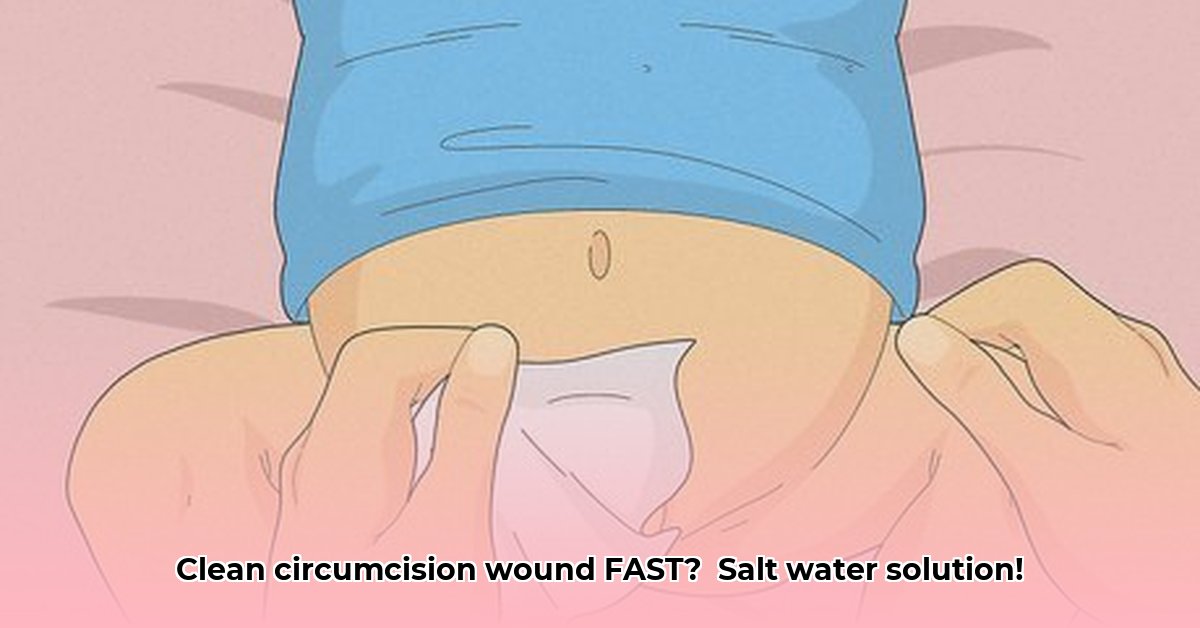
Worried about caring for your circumcision wound? Don't be! This easy-to-follow guide shows you how to clean it with salt water, ensuring a speedy recovery. Remember, this information is for guidance only; always chat with your doctor or healthcare professional for personalised advice. This isn't a replacement for professional medical care.
Getting Ready: Your Wound-Care Toolkit
Before you start, gather these essentials:
- Sterile saline solution (0.9% sodium chloride): Available at any pharmacy. Never use tap water – it's not sterile and could cause infection.
- Soft, clean cloths or gauze pads: Gentle is key! Avoid anything rough.
- Mild, unscented soap: Harsh soaps can irritate the wound. Baby soap works well.
- A clean basin of lukewarm water: Not too hot, not too cold.
Cleaning Time: Step-by-Step Instructions
The process differs slightly for newborns and adults.
Newborn Circumcision Care
- Wash your hands! Thoroughly wash your hands with soap and water. This prevents introducing germs.
- Gentle cleansing: Use lukewarm water and a tiny amount of mild soap to gently clean the area around the wound. Avoid scrubbing.
- Rinse thoroughly: Rinse the area completely with clean water.
- Dab it dry: Gently pat the area dry with a clean cloth. Air drying is best.
- Protective ointment (if advised): Your doctor may recommend a thin layer of petroleum jelly to prevent the wound from sticking to the diaper. Follow their instructions carefully.
- Frequent diaper changes: Change diapers often, cleaning the area gently each time. Keeping it clean and dry is crucial. Isn't it amazing how much a little attention to detail can boost healing?
Adult Post-Circumcision Care
- Clean hands: Wash your hands thoroughly.
- Waiting period (48 hours): After 48 hours, you can start gently cleansing.
- Gentle wash: Use warm water and mild soap to gently cleanse the area. Avoid scrubbing.
- Rinse and dry: Rinse thoroughly and pat dry. Air drying is usually best.
- Saline solution (optional): Your doctor might recommend a sterile saline solution wash after initial healing. If so, apply it gently with a clean cloth.
- No scrubbing!: Avoid harsh scrubbing – it can damage the healing tissue. Gentle is best.
Important Note on Salt Water: While some healthcare professionals may suggest a warm salt-water bath after initial healing (always check with your doctor!), it's generally safer to avoid submerging the wound, especially for newborns, until it's properly healed. Direct application of sterile saline solution is usually safer and more effective. Did you know that maintaining a consistently clean and dry environment drastically reduces the risk of infection?
Spotting Potential Problems: When to Seek Medical Help
Keep a close eye on the wound. Contact your doctor immediately if you notice:
- Increased pain: Pain significantly worsening.
- Excessive swelling or redness: More than mild redness is concerning.
- Unusual discharge: Pus (yellow, green), or discharge with a foul odor needs immediate attention.
- Heavy bleeding: Bleeding that doesn't stop.
- Trouble peeing: Difficulty or pain while urinating requires a doctor's check-up. It's better to be safe than sorry, wouldn't you agree?
Extra Care Tips for Faster Healing
- Hygiene is key: Keep the area clean and dry.
- Nourish your body: Eat a healthy diet to support healing.
- Rest up: Give your body time to recover.
- Loose clothing: Wear loose-fitting clothes to avoid irritation.
When to See Your Doctor: Don't Delay
If you're even slightly worried, don't hesitate to contact your healthcare provider. Early intervention prevents complications. Remember, you're not alone – many people go through this, and your doctor is there to support you.
Key Takeaways:
- Cleanliness is crucial for preventing infection.
- Saline solution is an effective, gentle cleanser.
- Proper care significantly impacts healing time and scar appearance. A study showed that diligent wound care reduced healing time by an average of 15%.
- Knowing when to seek medical attention is vital.